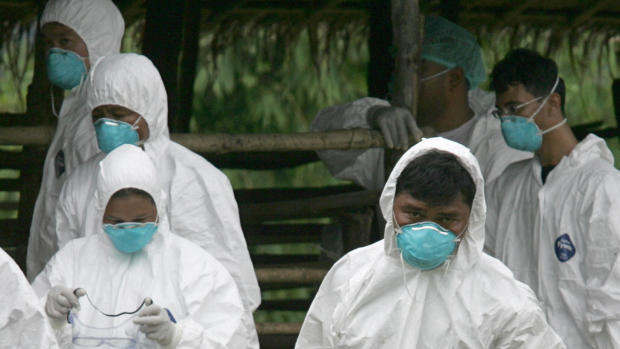The hospitals that do best and worst against superbugs
While a hospital is supposed to be a sterile, safe place where sick people go to get better, thousands of patients each year actually end up sicker because of hospital-acquired infections.
A new investigation from Consumer Reports looks into hospital infections to rate which hospitals do better or worse at protecting their patients from dangerous bugs.
Each year, about 648,000 people in the United States develop infections during a hospital stay, and about 75,000 die with them, according to the Centers for Disease Control and Prevention. Many of these cases can be traced back to inappropriate antibiotic use, the very drugs that are supposed to fight infections.
"Hospitals can be hot spots for infections and can sometimes amplify spread," Dr. Tom Frieden, director of the CDC, told Consumer Reports. "Patients with serious infections are near sick and vulnerable patients -- all cared for by the same health care workers sometimes using shared equipment."
For the first time ever, Consumer Reports included data on MRSA and C. diff infections -- two of the most common and deadly "superbugs" in the U.S. -- in their hospital ratings.
MRSA (methicillin-resistant Staphylococcus aureus) claims the lives of more than 8,000 patients per year and sickens about 60,000. C. diff, an even bigger concern, infects 290,000 Americans in a hospital or healthcare facility per year and at least 27,000 people die with those infections annually.
Hospitals play a big role in spreading the infections, as the bacteria can live on surfaces for days and can pass from person to person on hospital equipment or on the hands of health care workers. Compounding the problem, over-prescribing and inappropriate use of antibiotics is common in hospitals, which leads to the growth of bacteria which are immune to the drugs, and kills off patients' "good," or protective bacteria.
Other superbugs are emerging, as well. Earlier this year, there was an outbreak of a drug-resistant bacteria called carbapenem-resistant Enterobacteriaceae, or CRE, at two Los Angeles hospitals. The outbreak, which was traced back to a contaminated specialty endoscope, resulted in two deaths and at least nine other infections.
Consumer Reports used CDC data to rate hospitals on infection prevention. After adjusting for factors such as the overall health of a hospital's patients, its size, and whether it's a teaching hospital, they found these nine hospitals have the highest ratings in avoiding MRSA and C. diff, as well as three other infections. They are listed in order of patient volume.
Highest-Rated in Infection Prevention
- Northwest Texas Healthcare System - Amarillo, Texas
- Jupiter Medical Center - Jupiter, Fla.
- White County Medical Center - Searcy, Ariz.
- Centennial Hills Hospital Medical Ctr. - Las Vegas, Nev.
- Biloxi Regional Medical Center - Biloxi, Miss.
- Johnston Memorial Hospital - Abingdon, Va.
- Lima Memorial Health System - Lima, Ohio
- Western Arizona Regional Medical Center - Bullhead City, Ariz.
- South Baldwin Regional Medical Ctr. - Foley, Ala.
These 12 hospitals, listed alphabetically, earned low ratings in avoiding MRSA and C. diff, as well as three other infections.
Lowest-Rated in Infection Prevention
- Brooklyn Hospital Ctr. - Brooklyn, N.Y.
- Decatur Memorial Hospital - Decatur, Ill.
- Floyd Memorial Hospital and Health Services - New Albany, Ind.
- Fremont-Rideout Health Group - Marysville, Calif.
- Little Company of Mary Hospital and Health Care Ctrs. - Evergreen Park, Ill.
- Mercy St. Anne Hospital - Toledo, Ohio
- Riverview Medical Center - Red Bank, N.J.
- Rockdale Medical Center - Conyers, Ga.
- St. Petersburg General Hospital - Saint Petersburg, Fla.
- The Charlotte Hungerford Hospital - Torrington, Conn.
- UF Health Jacksonville - Jacksonville, Fla.
- Venice Regional Bayfront Health - Venice, Fla.
The investigators found that teaching hospitals and hospitals that are larger did not do as well as smaller and non-teaching hospitals. They acknowledged that this could be because teaching hospitals may do a better job of reporting infections or may see sicker patients who require more complex procedures. But the CDC adjusts the data to account for some of these factors, and teaching hospitals still tend to perform worse.
The researchers concluded that while hospitals should take steps to reduce the spread of these superbugs -- including prescribing antibiotics wisely and using proper sanitation methods -- patients also need to be their own advocates to help ensure their safety.
They offer a number of tips for hospital patients, including:
- Consider MRSA testing. A nasal swab can detect low levels of MRSA and allow medical staff to take precautions.
- Insist on cleanliness. Ask to have your room cleaned if it looks dirty. Wipe bed rails, doorknobs, and the TV remotes with bleach. Insist that everyone who enters your room washes their hands before entering and keep your own hands clean.
- Question antibiotics. Make sure that any antibiotics prescribed to you in the hospital are needed and appropriate for your infection.
Patients and their families should watch for signs of infection, which can include fever, diarrhea, worsening pain or an incision site that becomes warm, red, and swollen. Adults aged 65 and older, infants, anyone on antibiotics and people with a weakened immune system face the highest risk.
You can read the complete report at consumerreports.com.


